Tag Archives: AQI
May 17, 2014 The Big Dirty
The main reason staying for a long time in Beijing is hard, is the pollution. For everything else, there is some sort of a solution, a strategy to devise, a plan to undertake. The pollution however, is unavoidable and can be so unrelenting, it takes the edge off of you.
Now, I have heard that the french news went into conniptions recently because the capital had the unbelievable PM10 count of 180 during one single day which caused various newsmedia to liken the conditions in Paris to those in Beijing. That made me laugh. That was kinda cute.
It also made me grit my teeth. This tells you what the airquality in western Europe normally is like, and moreover, what europeans expect it to be, if one day of 180 PM10 is meted out in world news!
The truth is, I cannot explain what the kind of airpollution one experiences here, in the northeast of China (I am not even mentioning the water, the land and thereby in extenso the food) feels like, what it does to you, how it permeates everything in your life. People who have not lived in these circumstances simply do not know. No one in the west has lived through this kind of airpollution, has never experienced anything like the scale or composition that this modern chinese phenomenon has reached.
Beijing based businesses and organisations are sometimes having a hard time getting through to their bosses abroad that yes, they need extra funds for airfilters, extra holidays, that this is no place to be for families, especially those with young children, and, yes, occasionally, it is better to have their office crews work from home rather then brave the streets. Far too often, such complaints and requests are waved off as ‘whining’ because they cannot imagine what this is like.
Only people who have never breathed any kind of pollution can wave it off as whining. If the Beijing expats are whiners, then what are Parisians?
This is not to say that days like the one Paris recently experienced are okay and people should just accept that kind of pollution as a given, certainly not. Nor is this to say that those fighting for better air in Europe aren’t fighting for a just cause or that they are overreacting. Pollution is a slow poison that is too often overlooked and underestimated, far too often waved away as ‘whining’
Let me try to make a bit clearer to you what the pollution here is like, what it does, to me personally, and suspectedly, to other people.
Let’s start with the facts and the numbers.
So what am I talking about when I mention ‘PM2,5’ or ‘PM10’ or, as those who follow me on FB have seen me do often; ‘AQI’?
Technically, airpollution is a relatively young phenomenon. Nature also produces airpollution, mainly through duststorms, woodfires or volcanic eruptions, but the near everpresent blanket of haziness that makes breathing in developing cities sometimes literally a pain has only been around since 1860 or so, since industrialisation.
Science has therefore not really a full overview of what pollutants are nowadays being produced and which are more and which are less harmful to us.
For instance, lead was once a big problem, produced by vehicles, but the refining of fuel has since then developed such, that lead is, even in China, no longer a concern. Cars still emanate plenty of pollution of course, but lead pollution is no longer one of them. Likewise, there are new chemical components in modern pollution science has yet to do sufficient research on, as well as the suspicion that ‘ultrafine particles’ those even tinier then pm2,5, are more dangerous then the pm2,5 were recently discovered to be.
And those ultrafine particles aren’t even measured yet.
The pollutants science so far has the most extensive picture of, are also the particles that are measured by the two most common measure systems currently used in Asia. These pollutants are:
Ozone, which is an unstable form of oxygen. This ozone is not the same as the ozone layer that surrounds the earth at stratopheric levels that protects us from the radiations of the sun and the universe.
Carbon Monoxide, which is estimated to be emitted for 75 to 95% by combustion engine driven vehicles.
Sulphur Dioxide, that is produced by burning coal or oil, and can be found near power plants and refineries. It causes what we call ‘acid rain’
(Acid rain was a big thing halfway the eighties in Europe. Nowadays, I hardly ever hear nor read about it. Does this mean it is no longer a problem, or maybe no longer deemed a problem or that it is no longer in the collective consciousness?)
Nitron Dioxide, a byproduct of both vehicles and power plants (burning oil or coal) which, apart from it’s own toxic characteristics for human and animal life, will produce the bad ozone I spoke of above when hit by direct sunlight. (So clear days are not necessairily healthy days, alas)
And then of coure the particulate matter. Dust. Which we all are made of and will return to, but some dusts are better than others. Our bodies are able to filter dust out of our breathing systems, it is the reason why we snot, but this system was designed for particles the size of fine sand and the like, not for the very fine particles that combustion produces.
(Kitchens are for that reason not the healthiest spaces in the house, since cooking, too, produces fine particles, but the amounts of these being produced by normal day to day cooking are not large enough to cause real longterm problems like airpollution can. Though I know from experience that frying some dried chillipeppers can nearly choke you!!)
Fine particles are categorized according to their size; PM10 is dust equal or smaller then 10 microns, but bigger then 2,5 microns. PM2,5 is any particles as small as or smaller then 2,5 microns in diameter.
Ultrafine particles are those that are smaller then 0,1 micron. Viruses fall within this range.
PM 10, when inhaled, typically reaches till the upper parts of our lungs, to the level of the bronchii. PM2,5 reach all the way down to the deepest levels, where the alveoli are, and can pass through the membranes there that the oxygen also passes to reach our bloodstream.
PM2,5 is classified as a cancer risk by the WHO. The more you breathe it, the longer you are exposed to it, the higher the risk you run to develop cancer later in life.

To put the size of these harmful particles in perspective: a human hair is usually around 100 micron in diameter. A cell measures between 6 and 10 micron, a bacteria measures around 1 micron (and therefore falls in the PM2,5 micron range) Molecules are no bigger then 0,03 micron.
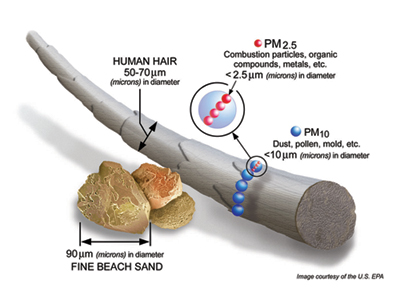
There are two accepted ways to translate the measurements of the above mentioned pollutants into a general pollution number: the Air Quality Index (AQI) as used by the United States’ environmental protection agency, and the Air Pollution Index (API) used by the Malaysian authorities. Both systems measure the pollutants I mentioned so far, and their respective readings differ only a bit from each other. But the conclusions and classifications they turn out are wholly different.
In China, the local governments of most cities use the API system and have the results available to the public on various websites. The Chinese state television, aptly named CCTV, displays the numbers.
This is actually a huge thing. I mention it casually, as I am already used to having an app on my smartphone that tells me hourly what the pollution reading for Beiijing is according to the Beijing government, and setting off the US embassy data against it, but the fact that these data are available is a huge difference to the situation when we arrived here, a mere two and a half years ago. Back then, there was no data available.
Well, no, that is not entirely true. The Beijing government did give out a pollution number. Just the number though. No measurement data whatsover, except the PM10 measurement. Just that. The numbers were generally about a third of what the US embassy posted on their website. The US embassy published, as they still do, the PM2,5 measurement and the overal AQI number along with the categorization that this AQI corresponds to. So if the US put up ‘170’ which is considered ‘unhealthy’ according to the AQI system (General AQI advisory at ‘unhealthy’: “Avoid all outdoor activities, particularely for infants”) the chinese website put up a number near the 50’s, calling the air ‘good’
We were in our second week, when the haze was so thick, it even made the tower of the prestigious merchant’s bank just opposite the street of our building hazy. We visited some friends in town, and when we came back, we both had to lie down because we didnt feel well. A feeling that is very similar to car sickness: nauseous, headache, and so, so tired.
The US embassy reading was 500AQI that day, maximum reading, the number above which, at the time, machines could not accurately measure the concentration of pollution in the air.
The american embassy put out a statement in which they said the Beijing airpollution was ‘just terribly bad’
Irritatedly, the Beijing government, that had put up a 200 something number calling the circumstances ‘mildly polluted’, blocked the US embassy website and demanded apologies from the Americans for ‘blackening the image of China to the world’
Those westerners, all they want is speak badly about China, they are just jealous, they are just always whining!
The US ambassador did not apologize, as far as I know. The site was unblocked however, but now displayed “when exposed for 24 hours at these levels” under every AQI number and interpretation. The Beijing official numbers meanwhile, stayed at roughly a third of what the embassy was reporting.
When we asked our driver or our ayi about the pollution and the haze, they smiled nervously and said that ‘the weather today is not so good” Or “yes, there is often mist here, in Beijing” The word pollution they simply pretended not to hear nor did they never use that word themselves, not in english nor in chinese.
But for mist, one needs humidity. And humidity, Beijing sorely lacks 9 months out of the year. Only in may, june and july, when the big rains come, can one experience actual, real mist in Beijing.
Then, one day, I do not remember exactly when anymore, about one and a half year ago, the Beijing government started publishing the official API numbers. With all the separate measurements listed under it.
In my pollution app, there appeared a map with all the API numbers on it of all the individual measure stations China possessed, showing an interesting array of multicoloured numbers all over the country, from which one could easily deduce where the heavy industry was located and what the wind was doing. The numbers published for Beijing were still laughably low.
As time progressed, measurement stations were added all over the country and all over Beijing. And as time progressed, I also saw the chinese numbers slowly creep closer and closer to the US ones.
They still differ, but do so now in such a way, that I suspect this has more to do with differences in interpretation, as well as the Chinese API number for Beijing being a general number composed of many measurements taken all over the city, from the far east to the far west. In less than two years, not only have the Chinese installed an impressive network of measure stations, pollution has been lifted out of the taboo sphere, and placed itself on top of the political agenda. More and more Chinese are wearing masks on bad air days. The US embassy is no longer chastized for publishing air pollution data, on the grounds of ‘mingling with the business of another sovereign state’ The driver and the ayi no longer smile nervously, but frown, when they say ‘the pollution today is very bad’ And note that they now use that very word: pollution. Both in english and in chinese.
This change I think we owe to the airpocalypse of last year, january 2013. The month where pollution reached truly unthinkable levels. The US embassy measurements, now able to detect concentrations higher then 500, (another indication of how fast development is going) reported numbers above this maximum, the so called ‘beyond index’ for a whopping four days in a row, days that fell within ten continuous days that were classified as either very unhealthy (AQI of 201-300) or hazardous (AQI 301-500) Do realize, that from 400 AQI onwards, the PM2,5 reading and AQI reading are the same.
One of these beyond index days broke the 800 AQI. The next day saw the 1000 AQI breached.
Not even the Chinese government could pretend any longer that pollution was a minor issue taken out of proportion by the whining west.
I wasn’t in Beijing during that time, but my girl was, and she told me her eyes hurt when she went outside, and she could physically not breathe properly on those two horrendous days.
In Japan, where I was having a snowboard holiday, the layer of snow deposited in the week after the airpocalipse was brownish, and clearly visible in the snowpack.
So now you have read plenty of numbers, but what do these numbers actually mean? Without perspective, how are you going to know what it means, when I say the AQI is 170 today? (which is a fairly normal day in Beijing I’d say) What do you balance this information with? What kind of AQI or PM readings do European cities have, generally? What exactly is the WHO limit for airpollution? What does a number like that feel like, breathe like, look like?
There are actually two different limits set in (and by) the west.
The EU has set the limit for PM2,5 on a maximum of 25.
Per year.
Together with a limit of no more then 40 PM2,5 per day.
The WHO goes further, setting the maximum for one year at a count of only 10 PM2,5. A count that, I am sure, many European cities also cannot avoid exceeding.
Let’s assume the WHO is whining. Let’s assume the EU is also whining. Let’s say that actually double the numbers the EU advises, are just fine for human life. That would mean that a general measurement for a full year should not be higher than 50, and no more than 80 on any single day.
Let’s not be whiners and take double the EU limits as standard. Where does that leave us in Beijing?
Still shitf*d, that’s where.
According to official reports, the amount of days that the airquality can be considered either unhealthy, very unhealthy or hazardous (with an AQI of 160 or over, double the ‘non whining’ standard I just set above) is 220 days per year in Beijing.
22 days out of the year (as measured over the past few years) the measurements exceed the WHO limit a whopping 50 times or more.
The amount of days per year in Beijing that fall within the official WHO limits are 20 days. Just under three weeks. Even if we count according to the ‘non-whining’ option as mentioned above, the amount of days in Beijing that would be considered ‘okay’ according to daily measurements would be a mere 100 days. The yearly totals are bad no matter which limits you choose to measure them against: average daily pm2,5 level in Beijing is 90.
So now we’ve had a load of numbers which paint a very dark picture. In comparison, in the Netherlands, parliament asks the qovernment questions about what measures to take when the airpollution due to rare weather conditions, reaches over 60 AQI in the south of the land for one single day. In London, brits go berserk because they witness a few days of 160 or above (which, by the way, is indeed pretty bad!) Compare that to the Beijing numbers and you might come to understand the enormous differences. But that doesnt mean you actually know what the difference is like, what it feels like.
Many tourists do not notice much of it. The effects airpollution has on a single individual differs enormously. There are people who are sick when the AQI hits 300, there are those that bike to their work whistling all the way. -with a mask on, I should hope- I am someone whom it effects a lot. My girl however, hasn’t had much of a problem these past three years. I suspect that smokers have less problems with it in general. Their bodies are used to a daily dose of airborne poison. And, as one smoker smilingly said; I am breathing the same kind of shitty air. But I at least have a filter with it!
Tourists generally aren’t here for long enough to ‘appreciate’ what the northeastern chinese pollution is like. One can, after all, get lucky, in Beijing. There are good weeks. Or weeks that have many days hovering around the 150 level. Not good, but also not so hazy or choking that it would impact your holiday. For those busy wandering through the hutongs, the temples, the forbidden city, they might not even notice it was a 180 AQI haze above them that made the light so distorted and contrastless. Being in that air for two or three weeks will most likely give no problems beyond a mild rash and a cough, both of which will dissapear as soon as you are back in a healthy(er) environment.
This is the only comparatively ‘good’ news the researchers can give us about air pollution: the negative health effects of airpollution will, provided you go (back) to a healthy environment, diminish over time. Given time, your body recuperates from air pollution. Slowly, but surely, your chances of getting cancer diminish.
Therefore, the best you can do, so urge the Beijing based US doctors of the SOS clinics, is to limit your exposure to airpollution. Wear well fitting masks (and the “well-fitting” is imperative here: badly fitted masks are no use at all) Do not do outdoor sports on days with an aircount over fifty (So say goodbye to biking, hiking or anything else on all but three weeks of the year) Do not even go outside on very bad days (In unfiltered houses, the air can reach up to two thirds of the count outside, depending on how often doors and windows are opened..) Take as many holidays in healthy environments as possible, to give your body the time to recover.
It is a slow poison. During daily Beijing life I do not notice the effects that much, mainly because the effects are there every day. One forgets. Only when I return to Europe, or go to Japan, and stay there for two weeks or longer, do I feel the difference. It startles me. The difference in stamina, which is huge, even when untrained. How much more deeply I sleep, how well rested I am in the morning. The difference to my skin, that is without rashes when in healthy environments. I cannot wear jewelry when I am in Beijing, for instance. My skin grows red and itchy almost immediately. After two weeks back home, I can wear jewelry without problems. (The dryness in Beijing surely doesn’t help, either) After two weeks in a healthy environment, I look ten years younger then I do while in Beijing. My cough disappears. After a week, I realise I have no headaches anymore. And my mood is so much more uplifted. These effects of a healthy environment last on a little while after I’ve returned to Beijing: the first two, three weeks after a getaway to Europe I feel good still, strong, unfettered. This slowly gets eroded away. Beijing pollution doesnt kill anyone fast. But it is unrelenting. As the Beijing years draw on, and the amount of pollution heaps up in my lungs and my blood, I notice these effects more and more.
Everyone who lives in a place where the light diminishes in winter, knows the depressive feelings that the dark months of january and february can bring. Here in Beijing, one can experience something much alike, as in wintere there are days and days on end that the haze envelopes the city, allowing the sun to be only a pale white disk in the sky, the light low and dispersed, the sunset already glowing red at half past three, the sun already dissapearing at four. Not because the sun has sunk below the horizon, but because the sun has sunk below the pollutioncloud that hovers over Beijing.
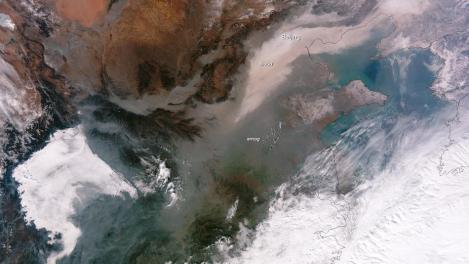
- The pollution as seen from space. Image taken by the international space station. The dark grey is smog, the white is clouds. Also clear is the edge of the mountians, that keep the smog locked in over the plains of northeastern China. To escape the smog, one has to drive at least four hours north or northwest from Beijing.
Sometimes, when flying to Beijing, you can see it: as the plane descends , the clouds shift from white to brown, the border marked by a darker layer of soot.
Had the pollution not been here, or not been this severe, living in Beijing would have been a great adventure. Now, it still is an adventure, a wonder on many days, an exciting time of learning, but it is a much darker, unhealthier one, one that tires you out, one that every so often, I just need to hide from in airfiltered rooms. One that I need to leave behind to go breathe fresh air, to recover from in a healthy place, much like tuberculosis patients were once sent to the mountains to recover. An adventure that requires you to grit your teeth and hold your breath and count the days till the wind turns towards the north and brings fresh breathable oxygen. Beijing can be great, ugly and gritty and sandy, overwhelming in it’s size and scope, the sheer magnitude of what is happening here and at what speed, exciting and contagious and just great, if only, if only, if only the pollution would not be there.

The view from our balcony to the east, on one of the few good days. (for the careful observer: mind the brown-yellowish haze close to the horizon on the left. If the day falls within WHO limits, the mountains at the horizon can be seen. This particular day does not fall within WHO limits, it is AQI 60 or so. In Beijing, that is a great day)

The same view at 5 am on a july morning. This is what an ordinary Beijing sunrise looks like. Count is around 180 AQI here. A fairly “normal” day, that one gets about 160 days per year of. Already 50 times beyond the WHO limit for daily dosage of pm2,5 and pm10..
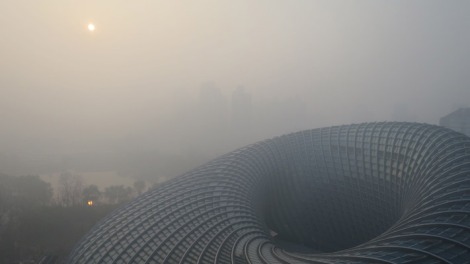
The same view on a mid march morning, around 10 am, AQI at 300 or thereabouts. This is what the sun will look like the rest of the day, till it dissapears at 4 pm. Whole weeks can pass by like this in winter, and it is a drag on the mind.

When the count hits 300 or more, I trade my flimsy plastic totobobo mask for this heavy, absolutely airtight one. Just to make a statement. Luke…. I am your father!
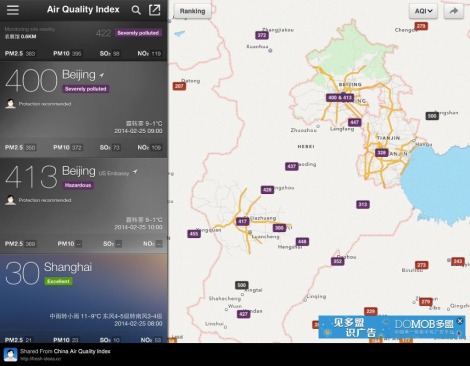
A screenshot from the airquality app. Note the pm2,5 count. Note, also, the difference in interpretation. On the map, one can clearly see where the industry is. And the wind is southerly, pushing it all up against the mountains north of Beijing…

The view from our apartment to the south, february 28th, 2013, at 7 am. AQI 500, beyond index. Note that the sun is already above the horizon, it has just come up, but it cannot pierce the thick smog..

Same view, the next day, after half a day of a northerly near storm. Northen wind is the thing to pray for here. It will blow all that sh*t over Korea to Japan and the pacific.

..For this is what the northernwind can do: note the graph. The wind turned to northerly around 3 or 4 am. at 6 am, the count has fallen down from a near 300 (which it had been for three full days prior) to a pristine 13. A sigh of relief indeed! (Well, actually I hollered instead of sighed…)

One of the IQ air filters, the new one still pristine white, the old one black, after a little under a year of use. This is the first filter, the one that filters out coarse particles.

IQ air came to the Beijing offices to inform everyone about pollution and the blessings of their product. They gracefully lent us their particle meter, with which one can measure the amount of fine particles down to the size of 3pm. So we checked our house. This is in the (big) living room, where there is just one machine, and the door to the balcony has been opened multiple times.

This is the reading done on the balcony. That is a nice amount of fine particles per cubic meter indeed! (AQI count close to 300 at that time, but I do not remember the precise number)
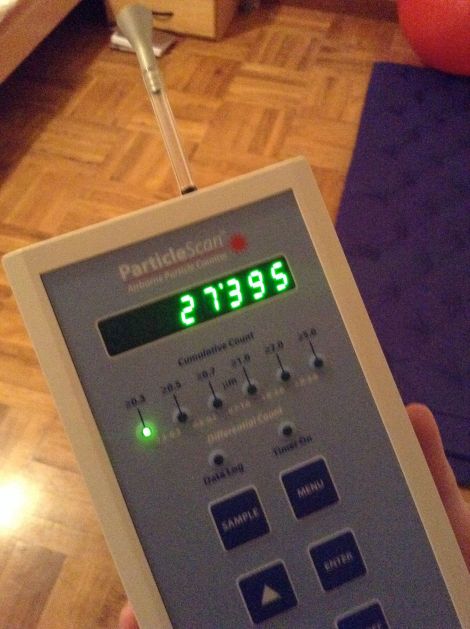
.. and the reading in the bedroom, which had it’s door closed and the airfilter in it on 5 (second fastest setting) for about three hours prior. Now that looks better!
- Leave a comment
- Posted under Beijing, Expat Life, pollution
